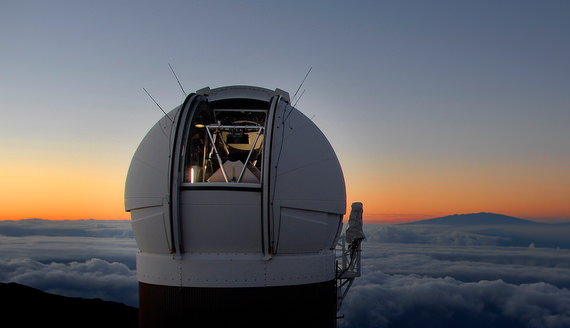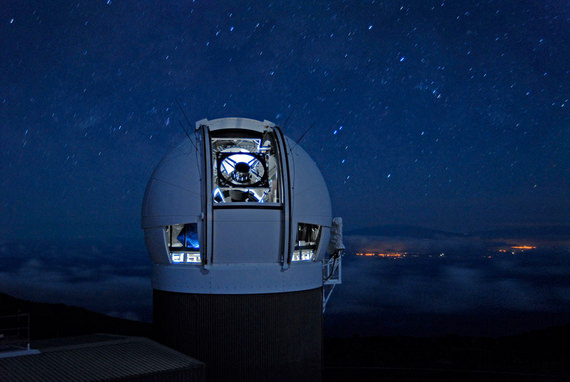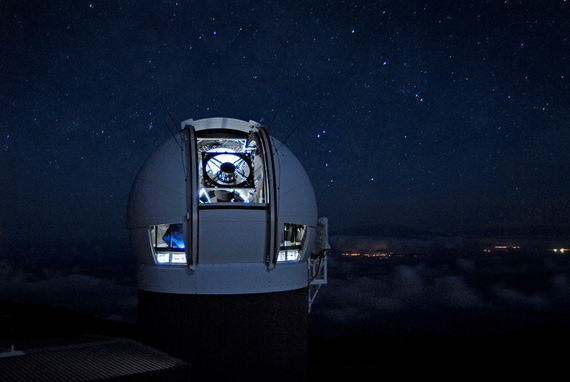[/caption]
There’s a new eye on the skies on the lookout for ‘killer’ asteroids and comets. The first Pan-STARRS (Panoramic Survey Telescope & Rapid Response System) telescope, PS1, is fully operational, ready to map large portions of the sky nightly. It will be sleuthing not just for potential incoming space rocks, but also supernovae and other variable objects.
“Pan-STARRS is an all-purpose machine,” said Harvard astronomer Edo Berger. “Having a dedicated telescope repeatedly surveying large areas opens up a lot of new opportunities.”
“PS1 has been taking science-quality data for six months, but now we are doing it dusk-to-dawn every night,” says Dr. Nick Kaiser, the principal investigator of the Pan-STARRS project.

Pan-STARRS will map one-sixth of the sky every month and basically be on the lookout for any objects that move over time. Frequent follow-up observations will allow astronomers to track those objects and calculate their orbits, identifying any potential threats to Earth. PS1 also will spot many small, faint bodies in the outer solar system that hid from previous surveys.
“PS1 will discover an unprecedented variety of Centaurs [minor planets between Jupiter and Neptune], trans-Neptunian objects, and comets. The system has the capability to detect planet-size bodies on the outer fringes of our solar system,” said Smithsonian astronomer Matthew Holman.
Pan-STARRS features the world’s largest digital camera — a 1,400-megapixel (1.4 gigapixel) monster. With it, astronomers can photograph an area of the sky as large as 36 full moons in a single exposure. In comparison, a picture from the Hubble Space Telescope’s WFC3 camera spans an area only one-hundredth the size of the full moon (albeit at very high resolution).
This sensitive digital camera was rated as one of the “20 marvels of modern engineering” by Gizmo Watch in 2008. Inventor Dr. John Tonry (IfA) said, “We played as close to the bleeding edge of technology as you can without getting cut!”
Each image, if printed out as a 300-dpi photograph, would cover half a basketball court, and PS1 takes an image every 30 seconds. The amount of data PS1 produces every night would fill 1,000 DVDs.

“As soon as Pan-STARRS turned on, we felt like we were drinking from a fire hose!” said Berger. He added that they are finding several hundred transient objects a month, which would have taken a couple of years with previous facilities.
Located atop the dormant volcano Haleakala (that’s Holy Haleakala to you, Bad Astronomer) Pan-STARRS exploits the unique combination of superb observing sites and technical and scientific expertise available in Hawaii.
Source: CfA


I am so liking this experiment. 1.4 Gigs… wow. NICE!
Stairway to Heaven?
Think array… say at 14,000 ft. somewhere…fibre optic link(s). Mmmmm…. tasty.
…or on the moon……….. or passing NEO asteroid. And sweet.
This Bad Daddy’s talking baseline here….
I cant imagine where technology will be in 100 years…
Sorry, but I just can’t help but be underwhelmed by the PanStarrs etendue, and the mere mention of the LSST gets me all tingly. Ever since the project was announced, nothing else will sate my appetite for sky surveying. Now the damn thing just needs to find itself funding.
I only have eyes for you, LSST.
Tay… Large Synoptic Survey Telescope it is….